Beavers tracks and sign can be found just about everywhere in North America, at least everywhere there’s a water source. Besides water there also has to be an ample amount of trees to fulfill their dietary needs, birch, willow and aspen to name a few. Beavers, Castor canadensis aren’t the most secretive animal inhabiting the land, if their around you’ll find evidence of their sign everywhere, dams, lodges, wood chips, felled trees, stumps and scent posts. 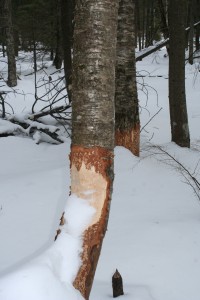
The tree in this picture at right was chewed by a beaver. Beavers eat the inner bark or cambium layer of trees. They also fell tree to get at the buds, leaves and newer, younger branches.
This image on the left shows a closeup of what a beaver chew looks like. Beavers as do other rodents chew at a 45 degree angle. You might find their chews several feet off the ground in the spring and summer months which would mean that that particular chew was made while the snow was deep sometime during the winter.
Beavers have unique tracks, some times their hard to find because they drag their tail as well as branches as they amble along. The tail and dragging branches will obscure their tracks if not wipe 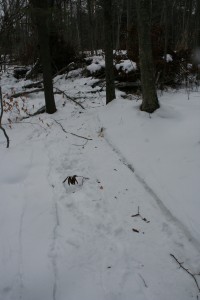 them out all together.
them out all together.
Here’ a perfect example of a beaver drag. In this particular picture the drag was about 5 foot wide obscuring all tracks that the beaver had left.
If you do find a nice clear set of tracks most likely they’ll be in the mud on the waters edge. Their front feet resemble small human like hands 2.5 to 3 inches long with 5 toes. Often times the front foot may only show 4 toes in the tracks but they’ll still look like long fingers with claws at the ends. A beavers rear track can be up to 7 inches long and looks somewhat triangular in shape. The hind tracks also have 5 toes and you should see some evidence of webbing between them. Claw marks should also be present in the tracks. Beavers have a gait pattern of a pacer, meaning all four of their feet will register independently. Some times however the hind  tracks will register on top of the front ones. With the wide tail drag and the unmistakable sign they leave you shouldn’t have any trouble identifying beaver tracks or mixing them up with any other mammals.
tracks will register on top of the front ones. With the wide tail drag and the unmistakable sign they leave you shouldn’t have any trouble identifying beaver tracks or mixing them up with any other mammals.
A good place to look for beaver tracks is along the muddy edges of their dams. You should also be able to find the spots they enter and exit the water. Beavers will use the same entry and exit points along the shore to go out and forage for food. Many times these trails will be churned up mud and their tracks will be evident. I have found some of my best beaver tracks on the winter ice where 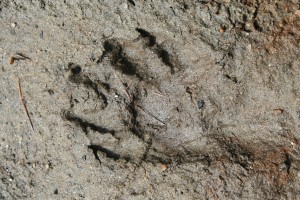 there’s a light snow cover. If you see an open hole in the ice with sticks or branches strewn about you may be able to find some good tracks there, just make sure the ice is at least 3 inches thick before you venture onto it.
there’s a light snow cover. If you see an open hole in the ice with sticks or branches strewn about you may be able to find some good tracks there, just make sure the ice is at least 3 inches thick before you venture onto it.
One of the other signs that beavers leave are their scat. Beaver scat can be very difficult to find since most times it’s deposited underwater, but if you know where to look it will be much easier to spot. 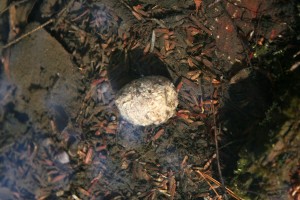 Beaver scat is in the shape of a pellet either round or elongated, about 3/4 to 1 inch in diameter. Their scat resembles wood chips or sawdust stuck together and is usually a light brown to tan color. If you look at the well worn entry trails into the water you may find scat just under the waters surface or at the edge of their dam. The pellets are usually scattered or solitary not found in a large pile like that of a deer or rabbit would be.
Beaver scat is in the shape of a pellet either round or elongated, about 3/4 to 1 inch in diameter. Their scat resembles wood chips or sawdust stuck together and is usually a light brown to tan color. If you look at the well worn entry trails into the water you may find scat just under the waters surface or at the edge of their dam. The pellets are usually scattered or solitary not found in a large pile like that of a deer or rabbit would be.
I found this adult beaver skull stuck in a dam on one of my outings a few years back. This shows a perfect example of the their incisors. The incisors are orange colored from the iron in the beavers diet. I don’t know how it met its demise but it will made an excellent addition to my skull collection.
If you stumble across beaver habitat on your next outing scout around and see if you can locate some tracks or scat. Learning how to identify animal sign and the creatures that left them can be a very rewarding experience.
Happy Hiking !!
If you carry it in, you carry it out, please put litter in it’s place!!!






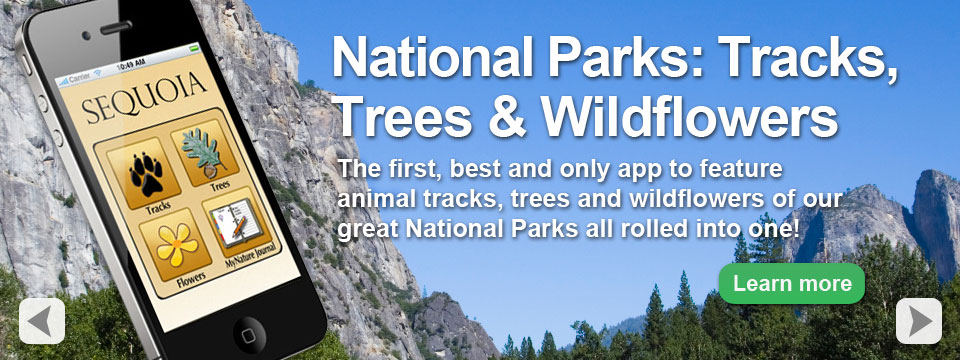
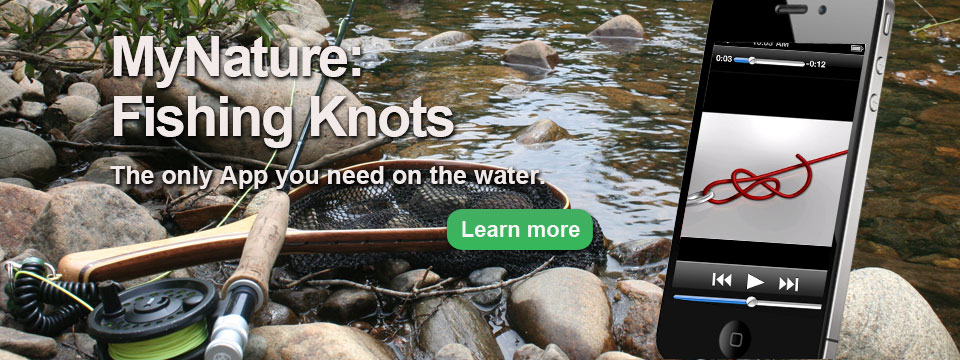

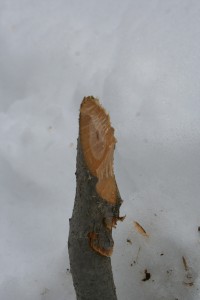

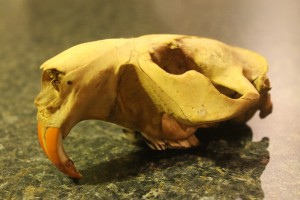




What Others Have to Say